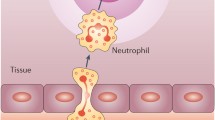Abstract
When grown in defined media, 15 of 21 laboratory and clinical strains ofNeisseria gonorrhoeae produced one or more factors (cytotaxins) chemotactic for human polymorphonuclear leukocytes obtained from normal individuals. Production of the cytotaxin(s) depended upon the media in which the bacteria were grown and the growth phase of the cultures, as well as upon the strain of gonococcus.
Similar content being viewed by others
Literature Cited
Arko, R. J., Bullard, S. C., Duncan, W. P. 1976. Effects of laboratory maintenance on the nature of surface reaction antigens ofNeisseria gonorrhoeae. British Journal of Venereal Diseases52:316–320.
Boyden, S. 1962. The chemotactic effect of mixtures of antibody and antigen of polymorphonuclear leukocytes. Journal of Experimental Medicine115:453–466.
Cutler, J. E. 1974. A simplein vitro method for studies on chemotaxis. Proceedings of the Society for Experimental Biology and Medicine147:471–474.
Cutler, J. E. 1977. Chemotactic factor produced byCandida albicans. Infection and Immunity18:568–573.
Hebeler, B. H., Young, F. E. 1975. Autolysis ofNeisseria gonorrhoeae. Journal of Bacteriology122:385–392.
John, T. J., Sieber, O. F., Jr. 1976. Chemotactic migration of neutrophils under agarose. Life Sciences18:177–182.
Kellogg, D. S., Jr., Peacock, W. L., Deacon, W. E., Brown, L., Pirkle, C. E. 1963.Neisseria gonorrhoeae. I. Virulence genetically linked to clonal variation. Journal of Bacteriology85:1274–1279.
McCutchan, J. A., Levine, S., Braude, A. I. 1976. Influence of colony type on susceptibility of gonococci to killing by human serum. Journal of Immunology116:1652–1655.
Nelson, R. D., Quie, P. G., Simmons, R. L. 1975. Chemotaxis under agarose: A new and simple method for measuring chemotaxis and spontaneous migration of human leukocytes and monocytes. Journal of Immunology115:1650–1656.
Norrod, P., Williams, R. P. 1978. Effects of iron and culture filtrates on killing ofNeisseria gonorrhoeae by normal human serum. Infection and Immunity21:918–924
Oates, S. A., Falkler, W. A., Jr., Joseph, J. M., Warfel, L. E. 1977. Asymptomatic females: Detection of antibody activity to gonococcal pili antigen by radioimmunoassay. Journal of Clinical Microbiology5:26–30.
Ofek, I., Beachey, E. H., Bisno, A. L. 1974. Resistance ofNeisseria gonorrhoeae to phagocytosis: Relationship to colonial morphology and surface pili. Journal of Infectious Diseases129:310–316.
Wood, D. O., Brownell, G. H. 1975. Transformation of leucine and rifampin traits inNeisseria gonorrhoeae with deoxyribonucleic acid from homologous and heterologous origins. Journal of Bacteriology121:471–474.
Author information
Authors and Affiliations
Rights and permissions
About this article
Cite this article
James, A.N., Williams, R.P. Chemotactic factor(s) ofNeisseria gonorrhoeae . Current Microbiology 1, 341–343 (1978). https://doi.org/10.1007/BF02621366
Issue Date:
DOI: https://doi.org/10.1007/BF02621366




